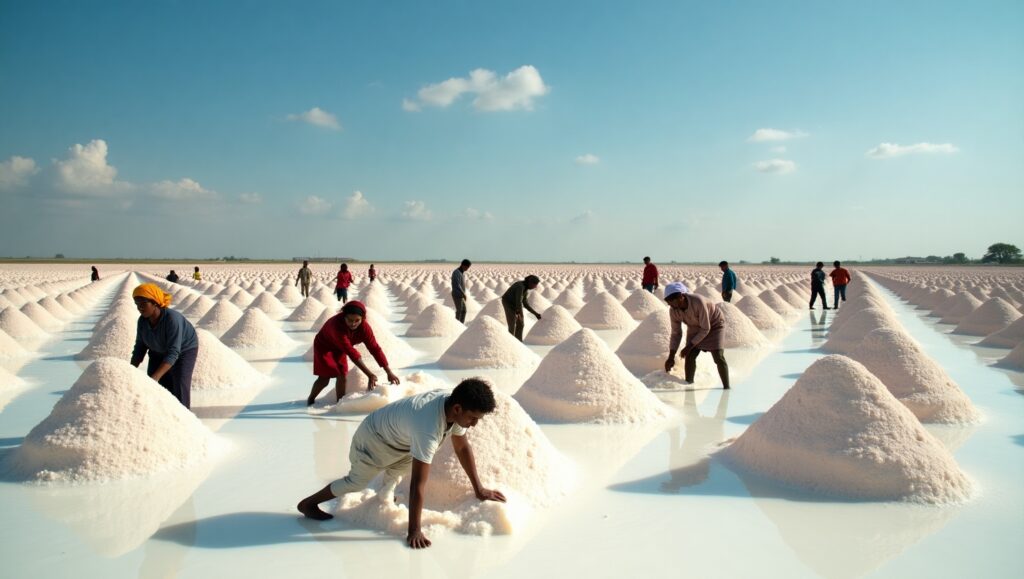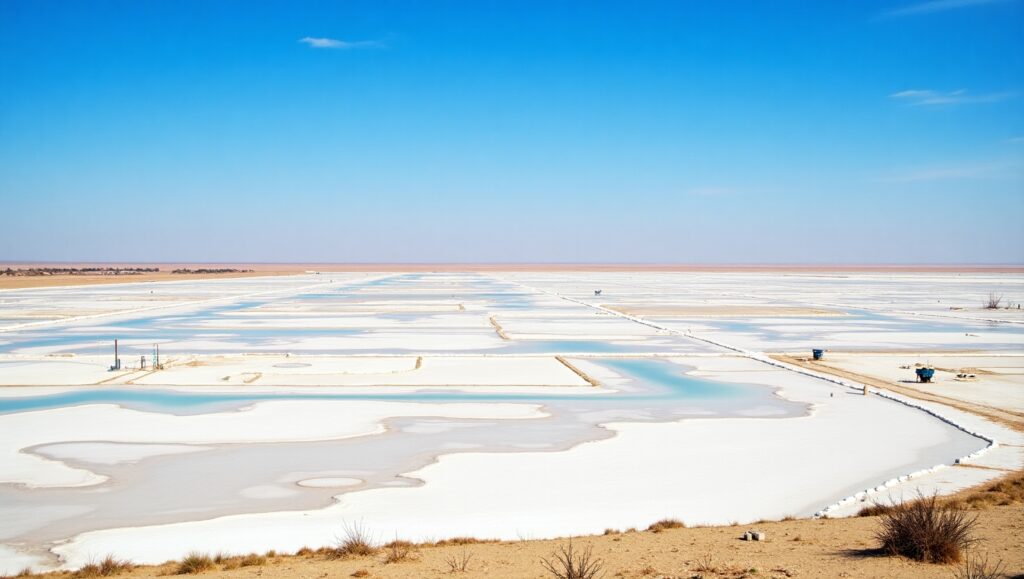When we think of Mumbai, our minds often jump to its bustling railway stations, colonial-era buildings, skyscrapers, and crowded beaches. But hidden behind the urban chaos lies one of the city’s oldest and most overlooked industries — the salt pans.

These vast stretches of white fields, shimmering under the sun, have been quietly producing salt for centuries, long before Mumbai became a financial hub.
Today, many Mumbaikars don’t even realize that their own city still has salt pans. Spread across areas like Mulund, Ghatkopar, Chembur, Wadala, and Turbhe, these lands are living reminders of the city’s unique geography, economy, and struggle for survival.
A Brief History of Mumbai’s Salt Pans
Salt production in Mumbai dates back to the 17th century, when the East India Company recognized the coastal wetlands as an ideal spot for salt farming. The British, always eager to control resources, taxed salt heavily and monopolized its trade.
Salt became more than just a commodity — it turned into a symbol of freedom and resistance. The famous Salt Satyagraha led by Mahatma Gandhi in 1930 was a direct protest against the British salt tax. While Gandhi marched to Dandi in Gujarat, the movement deeply impacted Mumbai too, where local salt workers joined the struggle.
For decades, the salt pans were also a major source of employment. Generations of families, often from marginalized communities, toiled in the blazing sun to scrape, dry, and collect salt crystals — known as “white gold.”
How Are the Salt Pans Formed?
The process of salt-making is as natural as it is painstaking:
- Seawater is allowed to enter the pans — large, shallow, flat plots of land.
- The water is trapped and left to evaporate under the scorching Mumbai sun.
- Slowly, salt crystals form on the surface, creating a glittering white carpet.
- Workers harvest the salt by hand, scraping it into piles.
The best time to witness this sight is during the hot months of January to May, before the monsoon floods the pans.
Why Are Mumbai’s Salt Pans Special?
Unlike Gujarat’s massive Rann of Kutch, Mumbai’s salt pans are relatively small. Yet they are special for several reasons:
- Historic Value: They are among the oldest industries of Mumbai, predating mills and docks.
- Environmental Role: Salt pans double up as flood buffers, absorbing excess rainwater during monsoons. Without them, Mumbai’s flooding problem would worsen.
- Scenic Beauty: At certain times of the year, the white patches glisten like snow under the sun — an unexpected sight in the middle of a bustling metropolis.
- Flamingo Haven: Areas like Sewri, Airoli, and Thane Creek near salt pans attract migratory flamingos, making them a paradise for bird watchers.
Where Are Mumbai’s Salt Pans Located?
Salt pans are scattered across the city, often tucked away behind highways, residential complexes, or industrial areas. Some of the notable ones include:
- Mulund Salt Pans
- Location: Eastern Express Highway, near Mulund East.
- How to Reach: Local train to Mulund (Central Line) → 10-minute auto rickshaw ride towards Eastern Express Highway.
- Chembur Salt Pans
- Location: Near Sion-Panvel Highway and Trombay Road.
- How to Reach: Get down at Chembur station (Harbour Line) → take an auto towards Deonar or Trombay.
- Wadala Salt Pans
- Location: Near Wadala Truck Terminus and Antop Hill.
- How to Reach: Wadala Road station (Harbour Line) → short ride to Antop Hill or Sion-Wadala Link Road.
- Turbhe & Airoli Salt Pans (Navi Mumbai)
- Location: Along Thane Creek, near Turbhe and Airoli.
- How to Reach: Local train to Turbhe/Airoli (Harbour Line or Trans-Harbour Line). These areas are also known for flamingo sightings.
- Ghatkopar Salt Pans
- Location: Along the Eastern Express Highway, near Pant Nagar.
- How to Reach: Get down at Ghatkopar station (Central Line) → 10-min auto ride towards Eastern Express Highway.
Visiting Mumbai’s Salt Pans
Unlike tourist attractions, salt pans are working fields. Most are not open to the general public, as they are privately owned or government-controlled. However, you can view them from the roadside or nearby flyovers.
For example:
- The Mulund salt pans are clearly visible from the Mulund-Airoli bridge.
- In Navi Mumbai, flamingo enthusiasts often gather near Turbhe salt pans during winter.
👉 Tip: If you are a photographer or nature lover, the best time to visit is early morning when the sun reflects off the salt fields, creating a surreal glow.
The Threats to Mumbai’s Salt Pans
Sadly, Mumbai’s salt pans are vanishing rapidly due to:
- Urban Development: Builders often eye salt pan lands for real estate projects.
- Environmental Degradation: Dumping of garbage and sewage into these areas reduces salt productivity.
- Decline in Salt Workers: Younger generations of traditional salt workers are moving away from this harsh profession.
Environmentalists warn that reclaiming salt pans for construction will worsen Mumbai’s flood problems, since they act as natural drainage systems.
The Future of Salt Pans in Mumbai
Several debates surround the future of these lands. While developers push for housing projects, environmentalists argue for their preservation. Some salt pans may also be converted into urban forests or mangrove protection zones.

What Makes a Visit Worthwhile?
Even though salt pans are not officially tourist spots, they offer:
- A window into Mumbai’s forgotten past, showing how the city once thrived on simple resources.
- An educational experience, especially for students of history, geography, and environment.
- Unique photography opportunities, especially during sunrise and sunset.
- A chance to spot flamingos and other migratory birds in the adjoining wetlands.
Quick Visitor Information
- Best Time to Visit: January to May (before monsoons).
- Nearest Railway Stations: Mulund, Chembur, Ghatkopar, Wadala, Turbhe, Airoli.
- Entry Fee: No official entry, as these are working sites. Viewing is free from outside.
- Photography: Allowed from outside, but for closer access you may need special permission.
Final Thoughts
Mumbai’s salt pans are more than just fields of white crystals — they are a living testimony to the city’s history, culture, and resilience. They tell the story of communities that toiled under the blazing sun, of protests that shook an empire, and of wetlands that still protect the city from drowning.
In a city where glass towers keep rising, the salt pans remind us of a simpler, humbler Mumbai — one that survived on the rhythm of the sea and the shimmer of salt.
So next time you’re crossing the Eastern Express Highway or driving through Navi Mumbai, take a moment to notice those wide, white patches glistening in the distance. They are not wastelands — they are Mumbai’s forgotten treasure.
Leave a Reply